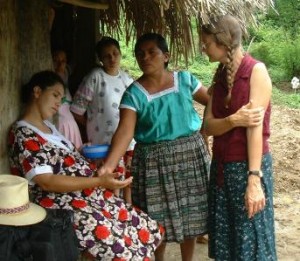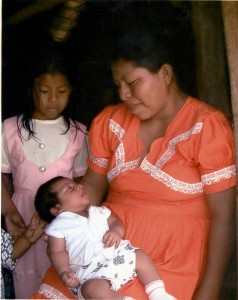Empowering Mayan midwives in rural Belize
May 7, 2012
 I went to Punta Gorda, Belize Central America to train Mayan women to deliver babies in their communities using Hesperian’s A Book for Midwives. Punta Gorda is a town in the southernmost part of Belize with a small hospital. Around the town are numerous Mayan villages. There is a bus service that goes two days a week to most of the villages, but for obvious reasons that is not a reliable way to get to medical help when a woman is in labor. Some of the villages might have one person who owned a truck and they soon became tired of being asked to transport people to town. They were especially leery of women in labor who might deliver in route and make a bloody mess in the process!
I went to Punta Gorda, Belize Central America to train Mayan women to deliver babies in their communities using Hesperian’s A Book for Midwives. Punta Gorda is a town in the southernmost part of Belize with a small hospital. Around the town are numerous Mayan villages. There is a bus service that goes two days a week to most of the villages, but for obvious reasons that is not a reliable way to get to medical help when a woman is in labor. Some of the villages might have one person who owned a truck and they soon became tired of being asked to transport people to town. They were especially leery of women in labor who might deliver in route and make a bloody mess in the process!
The 14 women who attended my training were selected by going to each village and holding meetings. This process took several trips. The first to see if there was an interest and try to set a date and time to return and hold the meeting. The next to actually hold the meeting and then another to follow up. That is if everything went smoothly, which of course was not always the case. In some villages one woman was selected and in others two and in others none. I wanted the women to do the selecting themselves. The midwives would serve their village and I wanted to empower the women by allowing them to decide who they wanted to be trained. Each village ultimately handled this process a little differently. Some wanted men and women to attend the meeting. Some already had selected someone when I returned to meet with them. The village of Jalacte had an especially large turnout and was the only village to hold an election were each women cast a ballot. In the end I had 14 woman who wanted to be in the midwife training.
I started with the first chapter of A Book for Midwives and worked my way through the book. Most of the women in the class were not midwives but wanted to learn. A few had helped at a small number of births. Alfonza, the oldest in the group, had been to lots of births but was afraid to say so at first not knowing if she might get into trouble. As time went on I gained her confidence and we became fast friends. I especially liked it when she would contribute to the discussion and it would be something that we both had experienced at a birth.
I often made comments such as, “This is what I was taught” or “This is what I have seen,” then I would ask if they had a different way of doing it or a different understanding. I felt like it was important to not make the women feel like I thought I was smarter or better than them. I think that this was a good approach and that the women opened up to me and trusted me.
In this part of the world, women are not given a lot of power. Many of them were not used to making decisions for themselves. They were often told what to do by their husbands and people in power. I found the chapters on step-by-step thinking, intuition, creativity and thinking about risks and benefits to be very helpful in teaching them to make decisions.
Many of the women had very little understanding about how their bodies work and how things look on the inside, so the chapters that covered those subjects were also very valuable.
In addition to class room time, I set up a schedule to go to each village and do prenatal checkups with the students and the pregnant women of the village. When I arrived for the first prenatal in the village of San Pedro I was met by two of my students who came running to my jeep waving their arms and shooting, “She is in labor, she is in labor, come quick!” We proceeded to the home of one of the women who we were supposed to be doing a prenatal exam on and sure enough, she was in good strong labor. Instead of a lesson in prenatal care, we had a lesson in childbirth! She delivered a healthy baby boy a few hours later to everyone’s delight.
 At our next day of class all the women were abuzz with the story about the birth. We were off to a great start. The subject for this class was danger signs to watch for during pregnancy, like the signs and symptoms of pre-eclampsia. At the end of class, one of the women came to me and told me about a woman in the village neighboring hers who she was worried about. She was expecting her 9th child and was “all swelled up.” We decided to go to her village next. It turned out that my student was correct, the pregnant woman did have a lot of swelling, her blood pressure was very high, she was experiencing headaches and to make matters worse, it had been raining so much that the road to her village was almost impassible. Soon buses and cars would not be able to get to her village. We decided that the best thing to do would be to transport her. The hospital decided to do a cesarean section and delivered a 9 pound baby (see the photo of the mother and her newborn baby above).
At our next day of class all the women were abuzz with the story about the birth. We were off to a great start. The subject for this class was danger signs to watch for during pregnancy, like the signs and symptoms of pre-eclampsia. At the end of class, one of the women came to me and told me about a woman in the village neighboring hers who she was worried about. She was expecting her 9th child and was “all swelled up.” We decided to go to her village next. It turned out that my student was correct, the pregnant woman did have a lot of swelling, her blood pressure was very high, she was experiencing headaches and to make matters worse, it had been raining so much that the road to her village was almost impassible. Soon buses and cars would not be able to get to her village. We decided that the best thing to do would be to transport her. The hospital decided to do a cesarean section and delivered a 9 pound baby (see the photo of the mother and her newborn baby above).
I heard many stories about breech babies dying while I was in Belize. Often the baby was alive when the feet and body were born but those in attendance would watch as the pink, kicking, limbs turned blue and stopped moving. The head was entrapped and by the time they were able to free it the baby was dead. I knew that the women of the villages would not call the midwives for the easy normal deliveries but would call them when there were problems. For this reason I thought that it was especially important to teach how to handle complications and how to deliver twins and breeches.
Eulaya in the village of Jalacte, which is located far from the hospital, was one of the Mayan women that I trained. The first two babies that she delivered were breech. Both babies survived. Eulaya has gone on to deliver many babies and to be looked up to by the women in her village.
Vicenta loved her copy of A Book for Midwives which soon became dog eared from studying it. She called me one day because she needed help transporting a women who was not due for another month but her water had broken and labor had not started. She was concerned that infection would set in if something wasn’t done. She had to walk from her village where there was no phone to the neighboring village to make the call. At first the hospital would not send an ambulance to pick up this woman so Vicenta called me to see what I could do. With some persuading I was able to convince the hospital to send an ambulance to pick up the pregnant woman and bring her to the hospital. Sure enough, Vicenta was right, the water was broken. At the hospital her labor was started by induction and mother and baby both survived.
One week later another woman in Vicenta’s village started bleeding early in her pregnancy. The bleeding was more than usual and wouldn’t stop. Vicenta again walked to the next village and this time when she called the hospital they knew who she was and they went right away to transport the woman who was bleeding. By this time the woman had lost so much blood that she was barely conscious, and needed a blood transfusion as well as a D&C.
I think that there is a great need for trainings like this one and that A Book for Midwives is an excellent manual for traditional birth attendants and community midwives.
Sincerely,
Deborah Flowers CPM, RN
Related articles
- Midwives Film Festival + me this weekend!! (itsbetterathome.wordpress.com)
Leave a Reply